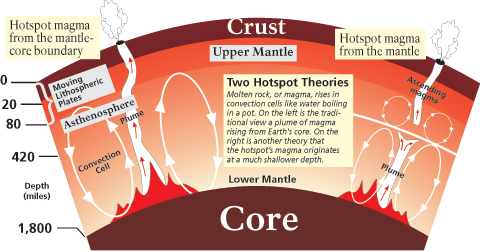Wyatt earp
Diamond Member
- Apr 21, 2012
- 69,975
- 16,382
- 2,180
Once again we don't know everything in the year 2017..
Is everything we know about volcanoes WRONG? | Daily Mail Online
Is everything we know about volcanoes WRONG? Textbook theory about thin jets of magma bursting up to Earth's surface may be incorrect
The textbook explanation of magma being spewed out from narrow jets deep within Earth is wrong, according to a new study.
Researchers now believe that these narrow jets – called mantle plumes - don't exist, and they say basic physics can back up their findings.
Mantle plumes have never had a sound physical or logical basis,' said Don Anderson, a professor at the California Institute of Technology.
According to current mantle-plume theory, heat from Earth's core somehow generates narrow jets of hot magma that gush through the mantle and to the surface.
Magma from the mantle beneath the plates bursts through the plate to create volcanoes.
'Much of solid-Earth science for the past 20 years - and large amounts of money - have been spent looking for elusive narrow mantle plumes that wind their way upward through the mantle,' said Professor Anderson.
Is everything we know about volcanoes WRONG? | Daily Mail Online
Is everything we know about volcanoes WRONG? Textbook theory about thin jets of magma bursting up to Earth's surface may be incorrect
- Conventional theory is that mantle plumes bring magma to the surface
- The thin jets are assumed to exist but scientists have never seen them
- New seismic data reveals large upward-moving chunks instead of jets
- What is driving motion is not mantle heat, but cooling at the surface
- When material in the planet's crust cools, it sinks, displacing material deeper in the mantle and forcing it upward, claims scientists at Caltech
The textbook explanation of magma being spewed out from narrow jets deep within Earth is wrong, according to a new study.
Researchers now believe that these narrow jets – called mantle plumes - don't exist, and they say basic physics can back up their findings.
Mantle plumes have never had a sound physical or logical basis,' said Don Anderson, a professor at the California Institute of Technology.
According to current mantle-plume theory, heat from Earth's core somehow generates narrow jets of hot magma that gush through the mantle and to the surface.
Magma from the mantle beneath the plates bursts through the plate to create volcanoes.
'Much of solid-Earth science for the past 20 years - and large amounts of money - have been spent looking for elusive narrow mantle plumes that wind their way upward through the mantle,' said Professor Anderson.








